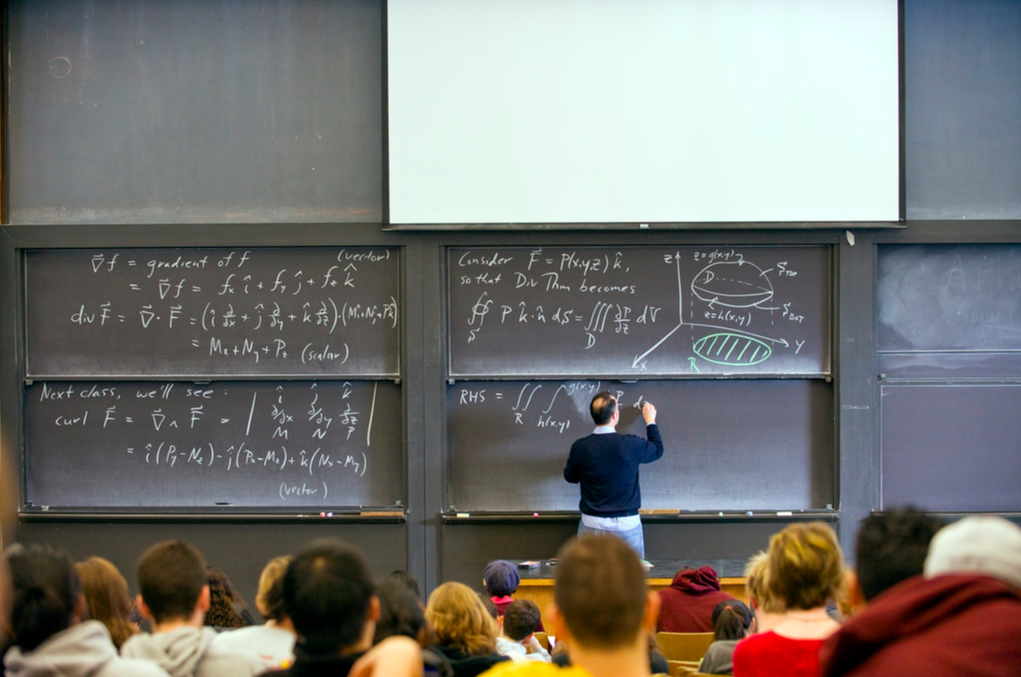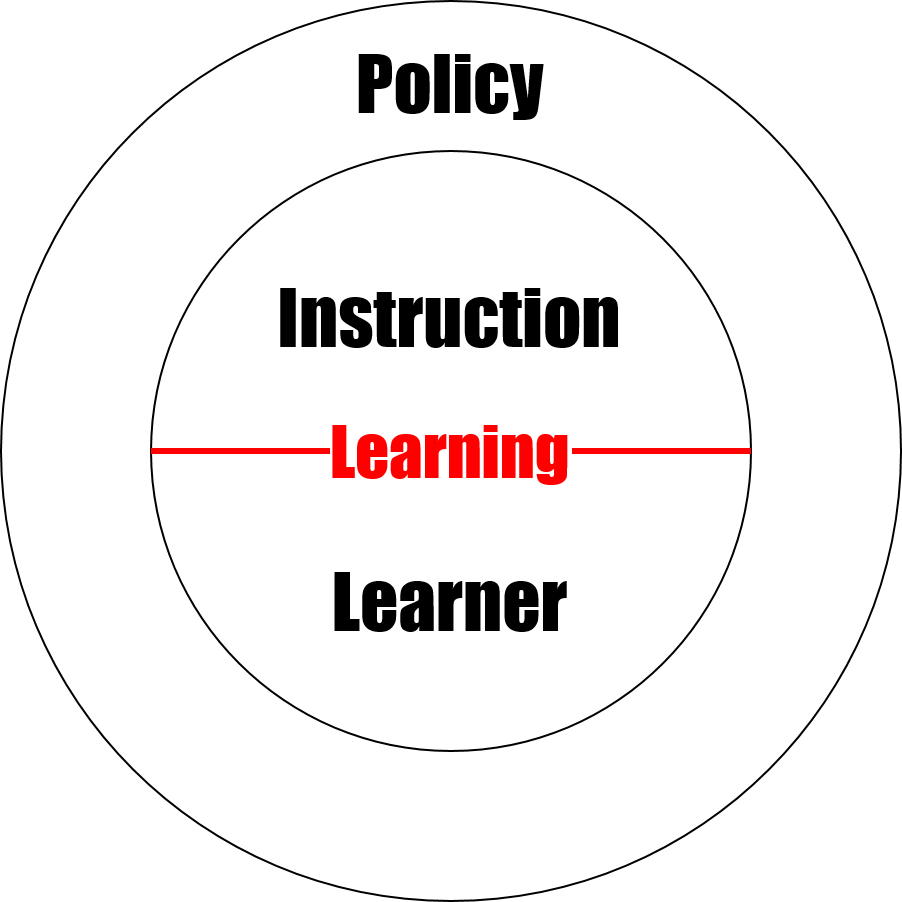
Have an opinion, improvement, or constructive criticism you'd like to share?
Please head over to our MIT Open "Science of Learning" forum to weigh in.
If you don't already have an account, creating one is quick. Thanks for your attention (and emotion)!
This post conceives of a "Learning Function"--a pseudo-mathematical representation of elements necessary for learning to succeed. The purpose is to shine a concise, coherent light on these elements, pointing out what is known and what is not, as a guide for educators--teachers, researchers, and others--on the mission of helping learners learn.
Learning is affected by:
-
Differences in learners
-
Differences in instruction
-
Differences in policy
Think of policy acting as an enabling environment in which learners interact with instruction. The interface itself is learning: the acquisition of competence.

The Learning Function represents what happens where learners interact with instruction. Pseudo-mathematically:

Think of engagement as the combination of attention and emotion. Keep in mind that engagement can be thought of in both minute-by-minute and day-by-day contexts. Minute-by-minute engagement means being on task in the moment. Day-by-day engagement, by comparison, has the learner coming back to the task over the longer term.
Like energy, attention is a finite resource. Attention needs to be applied strategically and efficiently. Emotion speaks to frame of mind. Emotion doesn’t have to necessarily be positive, but if negative, it can only be mildly negative (Pekrun, et.al., 2002).
To provide actionable insight to educators, it’s useful to look at differences in learners, instruction, and policy as they relate to driving attention and emotion.
Learner Differences
A learner’s ability to pay attention and be emotionally involved depends on learner conditions including the following:
- L1 - Prior competency: What does the learner already know? Vygotsky’s “Zone of Proximal Development” (ZPD) posits that learning only happens when the learner is challenged but not bored or overwhelmed (McLeod 2019).
- L2 - Motivation: What external force drives the learner? A grade? A promotion?
- L3 - Interest: What internal curiosity drives the learner? This can be hard to measure--a person likes an author or a subject or a task for reasons that may be hard to explain. But they know what interests them.
- L4 - Physiological Readiness: What is the learner’s physiological condition? Are they well-rested? Well-nourished? Physically fit? Mentally fit?
Instruction Differences
A learner’s ability to pay attention and be emotionally involved depends on instruction conditions including the following:
- I1 - Content: What is the subject matter? There’s some debate about knowledge vs. skill--traditional education tends to put knowledge at the center and build skill around the edges, sometimes only implicitly. A newer school of thought puts skill at the center, layering on knowledge as needed. Skills might be personal (identity, executive function, self-regulation), human (creative thinking, problem solving, communication, collaboration), and academic (reading, writing, math).
- I2 - Production Value: What’s the quality of the appearance of the content? It doesn’t have to be Hollywood level in the case of a video, for instance, but it needs to capture attention and emotion.
- I3 - Delivery: How does the learner receive the instruction? In-person (what group size) or digitally (via what type of device)? Synchronously or asynchronously? In what duration? How receptive vs. expressive is the learning experience? What other learning science findings are applied?
- I4 - Assessment/Feedback: How is the learner assessed and what kind of feedback does the learner get based on that feedback? How is the assessment information used: is it formative, meaning it’s used to guide instruction, or is it summative, meaning that it’s for a grade of some sort?
Policy Differences
A learner’s ability to pay attention and be emotionally involved depends on policy conditions including the following--these conditions tend to be binary in that they either put the learner into a good learning experience or they don’t:
- P1 - Law/Regulation: What laws and regulations allow or restrict access to learning?
- P2 - Access: Can the learner get access to the learning, or are they blocked by geography or funding, for instance?
- P3 - Resources: What funding is available to pay for instruction?
Tying it all Together: the Learning Function
All of the learner, instruction, and policy elements above combine to facilitate or block attention and emotion. As a result, the expanded Learning Function might be represented as follows (with the matrix elements representing the learner, instruction, and policy elements above):

In essence, the many variables in learning, instruction, and policy mean that each learner is unique. And unique learners need (unique) personalized learning.
Implications for Educators
Weaving the ideas above into a fabric suggests both implementation and invention actions and challenges. The following points elaborate on these actions and challenges, serving as a blueprint for how learning might be re-engineered.
A. Learners need to bring the right prior competence to each new learning experience
- ACTION: Deploy assessment to gauge what the learner knows and identify their next learning experience
- CHALLENGE: Good maps between what a learner knows (or doesn’t) and what instruction best meets their need simply aren’t pervasive
- CHALLENGE: The next learning experience depends on more than just a learner’s prior competence--appropriate physiological readiness must also be present
B. Learners need to be physiologically ready to learn: well-rested, well-nourished, “well-minded” (the latter meaning executive functioning skills, grit, growth mindset, …)
- ACTION: Provide time and resources to enable physiological readiness, including for athletics, arts, and activities
- ACTION: Implement appropriate homework policy
- CHALLENGE: Behavior change is hard
C. Learners need to find learning to be relevant
- ACTION: Help learners truly appreciate why they’re learning what they’re learning
- ACTION: Give learners some—but not too much—agency in what they learn
- CHALLENGE: Some learning is inherently difficult to tie to long-term future need
D. Learners need skills more than knowledge: for instance, identity, executive function, self-regulation; reading, writing, math; creative thinking, problem solving, communication, collaboration
- ACTION: Build learning experiences around these skills
- CHALLENGE: Re-organizing curricula and schools is challenging, especially in the face of state-wide curricula frameworks and testing built around knowledge
- CHALLENGE: Reading is the first academic challenge that many learners face, and humans aren’t inherently wired for reading the way they are for seeing and listening; when learners fail at reading, they run the risk of thinking they’ll fail at other academic pursuits (and with weak reading skills, they’re more likely to fail at these pursuits)
- CHALLENGE: Improving reading has thus far proven to be a daunting challenge
- Learners need to have their learning be personalized
- CHALLENGE: Precise assessments and instruction mapped to what that assessment reveals aren’t widely developed with the necessary precision
E. Learners need to be active
- ACTION: Make periods of receptive learning (reading, listening, watching) short, then transition to tasks that let the learner be expressive (writing, speaking, doing)
- ACTION: Create authentic projects
- CHALLENGE: Creating and delivering active learning is more difficult than receptive learning
F. Learners need to be guided by expert teachers
- ACTION: Provide time and resources (including availability of master teachers/coaches) to allow great teachers to flourish
- CHALLENGE: This time and these resources are hard to come by
Taken together, taking into account the learner needs above speaks to the what, when, where, how, and why of learning. The actions are straightforward but the challenges aren't trivial. Those challenges notwithstanding, there's a lot that we know about learning that isn't being implemented--that's low-hanging fruit we need to harvest.
The needed solutions aren't all-or-nothing--the actions we need to take and the challenges we need to surmount are relatively separate from one another. That said, the benefits will likely be additive if not multiplicative--a more physiologically ready learner is likely to be better able to appreciate relevance, for instance.
Have an opinion, improvement, or constructive criticism you'd like to share?
Please head over to our MIT Open "Science of Learning" forum to weigh in.
If you don't already have an account, creating one is quick. Thanks for your attention (and emotion)!
REFERENCES
McLeod, S,. "What Is the Zone of Proximal Development?," Simply Psychology. Updated 2019.
Pekrun, R., Goetz, T., Titz, W., Perry, R., "Academic Emotions in Students’ Self-Regulated Learning and Achievement: A Program of Qualitative and Quantitative Research," Educational Psychologist, 37(2), 91–105. 2002.